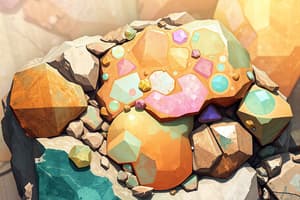Podcast
Questions and Answers
What property measures a mineral's resistance to scratching?
What property measures a mineral's resistance to scratching?
- Hardness (correct)
- Density
- Luster
- Cleavage
Which mineral class is characterized by containing both silicon and oxygen?
Which mineral class is characterized by containing both silicon and oxygen?
- Phosphates
- Carbonates
- Oxides
- Silicates (correct)
What test is used to determine the color of a mineral in powdered form?
What test is used to determine the color of a mineral in powdered form?
- Streak test (correct)
- Acid test
- Hardness test
- Density test
Which of the following is a characteristic of a mineral's cleavage?
Which of the following is a characteristic of a mineral's cleavage?
What is the primary purpose of mineral identification?
What is the primary purpose of mineral identification?
Which mineral class has a carbonate ion (CO3) and can effervesce with acid?
Which mineral class has a carbonate ion (CO3) and can effervesce with acid?
What is the purpose of a streak plate in mineral identification?
What is the purpose of a streak plate in mineral identification?
Which of the following describes a conchoidal fracture?
Which of the following describes a conchoidal fracture?
Flashcards are hidden until you start studying
Study Notes
Geology: Mineral Identification
1. Definition of Minerals
- Naturally occurring, inorganic solids.
- Specific chemical compositions.
- Ordered internal crystalline structure.
2. Key Properties for Identification
- Color: Initial observation but can be misleading.
- Streak: Color of the mineral in powdered form; tested on a porcelain plate.
- Luster: Quality of light reflection (e.g., metallic, vitreous, dull).
- Hardness: Resistance to scratching, measured using Mohs scale (1-10).
- Cleavage: Tendency to break along flat planes; described by direction and quality.
- Fracture: Irregular breakage patterns (e.g., conchoidal, hackly).
- Density: Mass per unit volume; can identify minerals with similar appearances.
- Crystal Form: External shape; reflects the internal arrangement of atoms.
3. Mineral Classes
- Silicates: Contain silicon and oxygen; most abundant group (e.g., quartz, feldspar).
- Carbonates: Contain carbonate ion (CO3); effervesce with acid (e.g., calcite).
- Oxides: Composed of oxygen and metals (e.g., hematite).
- Sulfides: Contain sulfur; often metallic (e.g., pyrite).
- Halides: Contain halogen ions; soluble in water (e.g., halite).
- Phosphates: Contain phosphate ion (PO4); important for fertilizers (e.g., apatite).
4. Identification Techniques
- Field Tests: Observing color, luster, and crystal form.
- Laboratory Tests:
- Streak test.
- Hardness test (using Mohs scale).
- Acid test for carbonates.
- Density measurement (using a balance and volume displacement).
5. Tools for Identification
- Hand lens or microscope for detailed observation.
- Mohs hardness kit for hardness testing.
- Streak plate for streak testing.
- Acid (hydrochloric) for effervescence tests.
6. Importance of Mineral Identification
- Essential for geological surveys and mining.
- Helps in understanding Earth's processes and materials.
- Aids in identifying potential resources and environmental studies.
7. Common Minerals for Identification Practice
- Quartz: Hard, glassy, often transparent or translucent.
- Feldspar: Has cleavage in two directions; often pink or white.
- Mica: Flaky, perfect cleavage; can be muscovite or biotite.
- Calcite: Reacts with acid; often white or colorless, with rhombohedral cleavage.
- Pyrite: Brass-yellow color; often mistaken for gold.
Use these properties and techniques to systematically identify minerals in the field or laboratory settings.
Definition of Minerals
- Minerals are naturally occurring and inorganic solids with specific chemical compositions and an ordered internal crystalline structure.
Key Properties for Identification
- Color: Initial indicator but not always reliable for identification.
- Streak: The powdery color of a mineral when tested against a porcelain plate.
- Luster: Describes how light reflects off the mineral's surface; types include metallic, vitreous, and dull.
- Hardness: Measured on the Mohs scale, indicating resistance to scratching, ranging from 1 (talc) to 10 (diamond).
- Cleavage: The tendency of a mineral to break along flat planes, characterized by specific directions and quality.
- Fracture: Describes irregular breakage patterns, such as conchoidal or hackly.
- Density: Mass per unit volume; helps distinguish between similar-looking minerals.
- Crystal Form: The external shape of the mineral, which reflects its internal atomic arrangement.
Mineral Classes
- Silicates: Most abundant mineral group containing silicon and oxygen (e.g., quartz, feldspar).
- Carbonates: Minerals containing the carbonate ion (CO3), which react with acid (e.g., calcite).
- Oxides: Composed of oxygen combined with metals (e.g., hematite).
- Sulfides: Minerals containing sulfur, often with a metallic luster (e.g., pyrite).
- Halides: Composed of halogen ions and typically soluble in water (e.g., halite).
- Phosphates: Contain the phosphate ion (PO4), important for fertilizers (e.g., apatite).
Identification Techniques
- Field Tests: Quick observations of color, luster, and crystal form in natural settings.
- Laboratory Tests:
- Streak test to determine powder color.
- Mohs scale for hardness testing.
- Acid test to check for carbonates.
- Density measurement using a balance and water displacement.
Tools for Identification
- Hand lens or microscope to observe detailed characteristics.
- Mohs hardness kit to determine a mineral's hardness.
- Streak plate used for streak testing.
- Hydrochloric acid for conducting effervescence tests.
Importance of Mineral Identification
- Critical for geological surveys, mining operations, and resource identification.
- Enhances understanding of Earth's processes and the materials that compose it.
- Plays a role in potential resource evaluation and environmental studies.
Common Minerals for Identification Practice
- Quartz: Hard and glassy, can be transparent or translucent.
- Feldspar: Exhibits cleavage in two directions, commonly found in pink or white shades.
- Mica: Flaky with perfect cleavage; includes varieties such as muscovite and biotite.
- Calcite: Reacts with acid, typically white or colorless, with distinct rhombohedral cleavage.
- Pyrite: Known for its brass-yellow color, often mistaken for gold.
Utilize these properties and techniques for effective mineral identification in both fieldwork and laboratory settings.
Studying That Suits You
Use AI to generate personalized quizzes and flashcards to suit your learning preferences.




